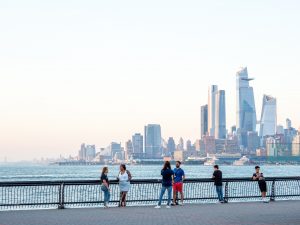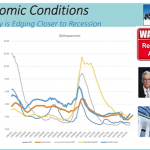New Jersey Future Blog
New Jersey’s population impacted by loss of immigrants
August 6th, 2020 by Tim Evans
For the past decade, the small annual increases in New Jersey’s population have been largely due to immigration, as the Star-Ledger reported—using New Jersey Future as a source—in a June story (“N.J.’s population would have fallen over the past decade if not for growing diversity, new data shows”) about how the steady stream of immigrants has made New Jersey increasingly diverse. But with recent changes in federal immigration policy, the stream of immigrants has slowed to a trickle, with implications for the state’s overall population growth.
Earlier this year, the release of the Census Bureau’s 2019 state population estimates revealed that New Jersey experienced a year-to-year population loss between 2018 and 2019—something that hadn’t happened since the 1970s—with total population declining by 0.04 percent, or 3,835 residents. The March release of county population estimates provided further clarity, showing that population losses are happening in just about every corner of the state rather than being a strictly urban or suburban or rural phenomenon. Only six of New Jersey’s 21 counties gained population over the last year, and even these were mostly very small gains.
Losses happening in Smart Growth locations as well
 The recently released 2019 municipal population estimates further reinforce the fact that New Jersey’s population losses are widespread, with 435 of the state’s 565 municipalities having fewer residents in 2019 than a year earlier. In every county other than Ocean, population-losing municipalities outnumbered gainers. While the story of population change in New Jersey for most of this decade has been about redevelopment—new growth happening in places that are already developed, having experienced their initial growth waves decades ago—this is not the case this year. Between 2018 and 2019, the 349 cities, towns, and mature suburbs that were at least 90 percent built-out (as of 2015) collectively lost 5,051 people, a 0.083 percent loss, after having dominated the state’s population growth earlier in the decade. But at the other end of the spectrum, sparsely-developed places on the exurban fringe are faring even worse than the mostly built-out places: The 68 municipalities that were less than 50 percent built-out as of 2015 experienced a cumulative population decline of 1,112 people since last year, representing a 0.255 percent decrease (a greater loss than the redevelopment areas, in percentage terms). This year, population changes appear largely independent of what type of place is being considered.
The recently released 2019 municipal population estimates further reinforce the fact that New Jersey’s population losses are widespread, with 435 of the state’s 565 municipalities having fewer residents in 2019 than a year earlier. In every county other than Ocean, population-losing municipalities outnumbered gainers. While the story of population change in New Jersey for most of this decade has been about redevelopment—new growth happening in places that are already developed, having experienced their initial growth waves decades ago—this is not the case this year. Between 2018 and 2019, the 349 cities, towns, and mature suburbs that were at least 90 percent built-out (as of 2015) collectively lost 5,051 people, a 0.083 percent loss, after having dominated the state’s population growth earlier in the decade. But at the other end of the spectrum, sparsely-developed places on the exurban fringe are faring even worse than the mostly built-out places: The 68 municipalities that were less than 50 percent built-out as of 2015 experienced a cumulative population decline of 1,112 people since last year, representing a 0.255 percent decrease (a greater loss than the redevelopment areas, in percentage terms). This year, population changes appear largely independent of what type of place is being considered.
Immigration rates dramatically affecting growth
Instead, the population stagnation that has gripped the entire state, afflicting both smart-growth areas and sprawling exurbia alike, appears to be tied to the macro factors discussed in New Jersey Future’s analysis of state population estimates earlier this year. In particular, recent changes in national immigration policy have caused net international immigration to drop nationwide and have had an outsized effect on New Jersey’s population dynamics, since New Jersey is a major immigrant destination and its population growth has been heavily dependent on immigrants in recent decades. As noted in our earlier analysis, New Jersey gained a net 50,087 international immigrants between 2015 and 2016 (an annual increase typical of most of the decade) but gained only 21,284 between 2018 and 2019—a decline of more than half.
The drop may be due to what is happening with the most recent and most vulnerable immigrants—those who are not yet United States citizens, whose residence in the country is hence the most tenuous and most at the mercy of changing policy. Nationally, from 2016 (prior to the change in administration) to 2018 (the most recent year for which data on citizenship status are available from the American Community Survey), the number of non-citizens has decreased by about 402,000, a 1.8 percent decrease, after increasing modestly (by about 21,000) from 2010 through 2016. In New Jersey, the number of non-citizens was already on the decline earlier in the decade, falling by a little over 12,000 (a 1.3 percent decrease) from 2010 to 2016, but dropped by nearly six times this amount—just under 73,000, an 8.0 percent decrease—in only two years, from 2016 to 2018.
Jersey City illustrates this phenomenon in microcosm. Its population of non-citizens declined by 1,186 between 2016 and 2018, after increasing by almost 8,000 from 2010 to 2016. While citizenship data are not yet available for 2019, Jersey City’s loss of 1,776 people between 2018 and 2019—the largest loss by far of any municipality in the state, and representing nearly half (46 percent) of the state’s total population loss—could easily be due primarily to a continuation of the downward trend in its non-citizen population.
In fact, given that New Jersey’s overall population loss from 2018 to 2019 was only 3,835, it is not at all hard to imagine that a further decline in the statewide non-citizen population — already down by 72,937 between 2016 and 2018, a sudden and dramatic acceleration of the trend from earlier in the decade — could be entirely responsible for the overall statewide loss, completely canceling out New Jersey’s already-slow growth from other sources.
Immigrant losses hitting smart growth locations
The drop in the non-citizen population is having a disproportionate effect on the compact, walkable places that have dominated population growth for most of this decade. Immigrants, and especially the most recent arrivals, tend to be drawn toward older cities and towns with traditional downtowns and a diversity of housing stock. Among the 32 municipalities in which non-citizens made up at least 20 percent of the population in 2016, a clear majority (26) score well on all three of New Jersey Future’s three smart-growth metrics — net activity density (population and jobs per square mile), presence of a mixed-use center, and local street network density — with another four scoring well on two of the three. Statewide, fewer than one in four municipalities score well on all three metrics, so compact, walkable places are substantially overrepresented among the magnets for recent immigrants. This group of 32 municipalities together lost more than 15,000 non-citizen residents between 2016 and 2018. If policy changes are resulting in recently arrived immigrants being sent back to their home countries before having the chance to become citizens, and in fewer immigrants choosing to come to New Jersey in the first place, this might have negative implications for downtown redevelopment efforts, by robbing the state of a key demographic group that has demonstrated an affinity for older cities, towns, and walkable suburbs.
General demand still strong for smart growth locations
The dramatic decline in the non-citizen population also calls into question the theory that the rebirth of the cities is over because Millennials have decided to move to the suburbs now that they’re having kids. Municipal population changes do not support the idea that people have suddenly decided to flee walkable urbanism for car-dependent suburbia. Rather, it may be that the people who have started leaving New Jersey in the last few years for reasons having to do with national policy just happen to have been concentrated in compact, walkable places. They are leaving those places, but because they are returning to their countries of origin, not because they want to move to a cul-de-sac subdivision.
Related Posts
Tags: immigrants, immigration, New Jersey, Population















